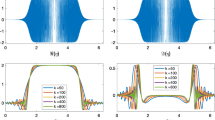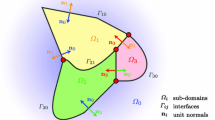Abstract
This paper is concerned with the cavity scattering problem in an infinite thin plate, where the out-of-plane displacement is governed by the two-dimensional biharmonic wave equation. Based on an operator splitting, the scattering problem is recast into a coupled boundary value problem for the Helmholtz and modified Helmholtz equations. A novel boundary integral formulation is proposed for the coupled problem. By introducing an appropriate regularizer, the well-posedness is established for the system of boundary integral equations. Moreover, the convergence analysis is carried out for the semi- and full-discrete schemes of the boundary integral system by using the collocation method. Numerical results show that the proposed method is highly accurate for both smooth and nonsmooth examples.




Similar content being viewed by others
Data availability
The datasets generated during the current study are available on reasonable request.
References
Colton, D., Kress, R.: Integral Equation Methods in Scattering Theory. Wiley, New York (1983)
Colton, D., Kress, R.: Inverse Acoustic and Electromagnetic Scattering Theory, 3rd edn. Springer, New York (2013)
Dong, H., Lai, J., Li, P.: A highly accurate boundary integral method for the elastic obstacle scattering problem. Math. Comput. 90, 2785–2814 (2021)
Evans, D.V., Porter, R.: Penetration of flexural waves through a periodically constrained thin elastic plate in vacuo and floating on water. J. Eng. Math. 58, 317–337 (2007)
Farhat, M., Guenneau, S., Enoch, S.: Ultrabroadband elastic cloaking in thin plates. Phys. Rev. Lett. 103, 024301 (2009)
Gazzola, F., Grunau, H.-C., Sweers, G.: Polyharmonic boundary value problems: positivity preserving and nonlinear higher order elliptic equations in bounded domains. In: Lecture Notes in Mathematics, vol. 1991 (2010)
Greengard, L., Rokhlin, V.: A fast algorithm for particle simulation. J. Comput. Phys. 73, 325–348 (1987)
Hackbusch, W., Nowak, Z.P.: On the fast matrix multiplication in the boundary element method by panel clustering. Numer. Math. 54, 463–491 (1989)
Haslinger, S.G., Movchan, N.V., Movchan, A.B., McPhedran, R.C.: Transmission, trapping and filtering of waves in periodically constrained elastic plates. Proc. R. Soc. A 468, 76–93 (2012)
Kirsch, A.: An Introduction to the Mathematical Theory of Inverse Problems, 2nd edn. Springer, New York (2011)
Kirsch, A., Ritter, S.: The Nyström method for solving a class of singular integral equations and applications in 3D-plate elasticity. Math. Methods Appl. Sci. 22, 177–197 (1999)
Kress, R.: A Nyström method for boundary integral equations in domains with corners. Numer. Math. 58, 145–161 (1990)
Kress, R.: On the numerical solution of a hypersingular integral equation in scattering theory. J. Comput. Appl. Math. 61, 345–360 (1995)
Kress, R.: A collocation method for a hypersingular boundary integral equation via trigonometric differentiation. J. Integral Equ. Appl. 26, 197–213 (2014)
Kress, R.: Linear Integral Equations, 3rd edn. Springer, New York (2014)
Kress, R., Sloan, I.H.: On the numerical solution of a logarithmic integral equation of the first kind for the Helmholtz equation. Numer. Math. 66, 199–214 (1993)
Lai, J., Li, P.: A framework for simulation of multiple elastic scattering in two dimensions. SIAM J. Sci. Comput. 41, A3276–A3299 (2019)
McPhedran, R.C., Movchan, A.B., Movchan, N.V.: Platonic crystals: Bloch bands, neutrality and defects. Mech. Mater. 41, 356–363 (2009)
Mikhlin, S.G., Prössdorf, S.: Singular Integral Operators. Springer, Berlin (1986)
Pelat, A., Gautier, F., Conlon, S.C., Semperlotti, F.: The acoustic black hole: a review of theory and applications. J. Sound Vib. 476, 115316 (2020)
Saranen, J., Vainikko, G.: Trigonometric collocation methods with product integration for boundary integral equations on closed curves. SIAM J. Numer. Anal. 33, 1577–1596 (1996)
Smith, M.J.A.: Wave Propagation through Periodic Structures in Thin Plates (Ph.D. thesis). The University of Auckland (2013)
Smith, M.J.A., Meylan, M.H., Mcphedran, R.C.: Scattering by cavities of arbitrary shape in an infinite plate and associated vibration problems. J. Sound Vib. 330, 4029–4046 (2011)
Stenger, N., Wilhelm, M., Wegener, M.: Experiments on elastic cloaking in thin plates. Phys. Rev. Lett. 108, 014301 (2012)
Watanabe, E., Utsunomiya, T., Wang, C.: Hydroelastic analysis of pontoon-type VLFS: a literature survey. Eng. Struct. 26, 245–256 (2004)
Watson, G.N.: A Treatise on the Theory of Bessel Functions. Cambridge University Press, Cambridge (1922)
Funding
The authors have not disclosed any funding.
Author information
Authors and Affiliations
Corresponding author
Ethics declarations
Conflict of interest
The authors declare that they have no conflict of interest.
Additional information
Publisher's Note
Springer Nature remains neutral with regard to jurisdictional claims in published maps and institutional affiliations.
Heping Dong is supported in part by the NSFC Grant 12171201. Peijun Li is supported partially by the NSF Grant DMS-2208256.
Appendices
A Representations and splittings of the kernels
The integral kernels of the operators L, S, K, R, H are given by
Here \(n(t):=\big (\gamma '_2(t), -\gamma '_1(t)\big )^\top \), \(n^\perp (t):=\gamma '(t)=\big (\gamma '_1(t), \gamma '_2(t)\big )^\top \), and
For the splitting (17), we have
where \(J_0\) and \(J_1\) are the Bessel functions of the first kind with order zero and one, respectively. The diagonal entries are given by
where C denotes Euler’s constant. We refer to [2, 13] for the details of the decomposition.
B Proofs for Theorems 6 and 7
1.1 B.1 Proof of Theorem 6
The function \({\mathcal {D}}\psi \) can be split into the following two parts:
where
with \(\alpha _j(t,t)=\partial _t \alpha _j(t,t)=\partial ^2_{tt} \alpha _j(t,t)=0, j=1,2,3,4\) and \(\alpha _j, \beta _j\) being analytic. We write the derivative \(\frac{{\textrm{d}}^{2}}{{\textrm{d}}t^{2}}({\mathcal {D}}\psi )\) in form of
where
By the interpolatory quadrature, the full discretization of \({\mathcal {D}}''\) can be written as
Noting \(p>1/2, 0\le q\le p, {\widetilde{\alpha }}(t,t)=0\), and the analyticity of the elements in \({\widetilde{\alpha }}(t,\zeta )\) and \({\widetilde{\beta }}(t,\zeta )\), we have from [15, Lemma 13.21 and Theorem 12.18] that
for any \(\psi \in X_n^2\) and \(\chi \in H^p[0,2\pi ]^2\), where the positive constants \(C_1\) and \({\widetilde{C}}_1\) depend on p and q. Since \({\mathcal {D}}''_n\psi =\frac{{\textrm{d}}^{2}}{{\textrm{d}}t^{2}}({\mathcal {D}}_n\psi )\), the above inequalities reduce to
where \(C_2\) and \({\widetilde{C}}_2\) are positive constants depending on p and q. By [15, Theorem 8.13], the proof is completed since the above inequalities hold for any q satisfying \(0\le q\le p\) and \(p>1/2\).
1.2 B.2 Proof of Theorem 7
Recalling the boundedness of \({\mathcal {N}}: H^{p}[0,2\pi ]^2\rightarrow H^{p-1}[0,2\pi ]^2\) and using (27), we have for any \(\chi \in H^p[0,2\pi ]^2, 0\le q\le p, p>1/2\) that
where \(C_1\) and \(C_2\) are positive constants depending on q and p, q, respectively. For any \(p>1/2\), it is clear to note that \({\mathcal {N}}_n\) and \({\mathcal {N}}_n-{\mathcal {N}}\) are uniformly bounded from \(H^p[0,2\pi ]^2\) to \(H^{p-1}[0,2\pi ]^2\).
For any \(\psi \in X_n^2\), it follows from Theorem 6 and \({\mathcal {N}}_n\psi ={\mathcal {N}}\psi \) that
Moreover, by Theorem 6, we have for any \(p>1/2\) that \({\mathcal {D}}_n\) and \({\mathcal {D}}_n-{\mathcal {D}}\) are uniformly bounded from \(H^p[0,2\pi ]^2\) to \(H^{p+3}[0,2\pi ]^2\). Combining (27) and (31), and noting the boundedness of \({\mathcal {D}}: H^p[0,2\pi ]^2\rightarrow H^{p+4}[0,2\pi ]^2\) and the uniform boundedness of \({\mathcal {P}}_n: H^{p+2}[0,2\pi ]^2\rightarrow H^{p+2}[0,2\pi ]^2\), we obtain
With the help of \({\mathcal {N}}_1\psi \in X_n^2\), the boundedness of \({\mathcal {N}}_2: H^{p}[0,2\pi ]^2\rightarrow H^{p+1}[0,2\pi ]^2\) and the uniform boundedness of \({\mathcal {D}}_n-{\mathcal {D}}: H^{p-1}[0,2\pi ]^2\) to \(H^{p+2}[0,2\pi ]^2\) and \({\mathcal {P}}_n: H^{p-1}[0,2\pi ]^2\rightarrow H^{p-1}[0,2\pi ]^2\) for \(p>\frac{3}{2}\), we deduce
Combining the above estimates yields
which completes the proof by noting that the operators \({\mathcal {E}}^{-1},{\mathcal {P}}_n: H^{p+2}[0,2\pi ]^2\rightarrow H^{p+2}[0,2\pi ]^2\) are uniformly bounded.
Rights and permissions
Springer Nature or its licensor (e.g. a society or other partner) holds exclusive rights to this article under a publishing agreement with the author(s) or other rightsholder(s); author self-archiving of the accepted manuscript version of this article is solely governed by the terms of such publishing agreement and applicable law.
About this article
Cite this article
Dong, H., Li, P. A Novel Boundary Integral Formulation for the Biharmonic Wave Scattering Problem. J Sci Comput 98, 42 (2024). https://doi.org/10.1007/s10915-023-02429-6
Received:
Revised:
Accepted:
Published:
DOI: https://doi.org/10.1007/s10915-023-02429-6
Keywords
- Biharmonic wave equation
- Scattering problem
- Boundary integral equations
- Collocation method
- Error estimates




